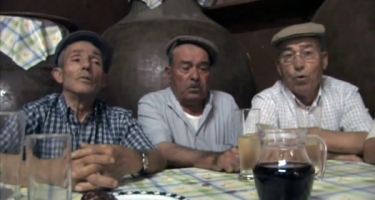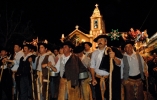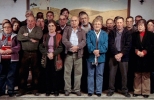Print
IDENTIFICATION | IDENTIFICACIÓN | IDENTIFICAÇÃO
Tangible or Intangible
Intantigle | Inmaterial | Imaterial
Image credits | Créditos de imagen | Créditos de imagem
Memoria Imaterial CRL
Title, name | Titulo, nombre | Título, nome
Cante Alentejano
Short description | Descripción corta | Descrição resumida
The cante alentejano is usually defined by the melodic structure and the type of performative organization that characterizes it, that is, the polyphonic singing performed in a group and without instruments. Divided among the “Point”, the “High” and the “Second voices”, a group of cante alentejano has as a repertoire the modas (songs) that among other topics, talk about work, love, contemplation and nostalgia. This cante is called alentejano because it originally came from that Portuguese region, Alentejo, which is situated in the South of the river Tejo and above the region of the Algarve.
O Cante Alentejano é usualmente definido pela estrutura melódica e o tipo de organização performativa que o caracteriza, ou seja, o canto polifónico executado em grupo e sem instrumentos. Divididos entre o “Ponto”, o “Alto” e as “Segundas Vozes”, um grupo de cante alentejano tem como repertório as “modas” que versam, entre outros temas, sobre o trabalho, o amor, a contemplação e a nostalgia. A este cante chama-se “Alentejano” por ser originalmente característico da região do “Alentejo”, região portuguesa que fica abaixo do Rio Tejo e acima da região do Algarve
O Cante Alentejano é usualmente definido pela estrutura melódica e o tipo de organização performativa que o caracteriza, ou seja, o canto polifónico executado em grupo e sem instrumentos. Divididos entre o “Ponto”, o “Alto” e as “Segundas Vozes”, um grupo de cante alentejano tem como repertório as “modas” que versam, entre outros temas, sobre o trabalho, o amor, a contemplação e a nostalgia. A este cante chama-se “Alentejano” por ser originalmente característico da região do “Alentejo”, região portuguesa que fica abaixo do Rio Tejo e acima da região do Algarve
Community or culture | Comunidad o cultura | Comunidade ou cultura
Alentejo
Practitioners, Autor | Practicantes, Autores | Praticantes, Autores
Ceifeiros de Cuba, Inácio, Frangãos, Ermelindo, Sarol, Pires, Teixeira, Cipriano, Roque e Machado
Museum | Museo | Museu
MEMORIAMEDIA e-Museu do Património Cultural Imaterial
Place | Local | Local
Cuba, Alentejo
Country | País
Portugal
Language | Idioma
Português
MEDIA
Video | Vídeo
Video credits | Créditos de vídeo | Créditos vídeo
Memoria Imaterial Crl
Audio
Audio Credits | Créditos de Audio
3D object | Objeto 3D
3D Credits | Créditos 3D
Text credits | Créditos del texto | Créditos do texto
Filomena Sousa, Memoria Imaterial CRL, IELT/FCSH-NOVA
Record date | Fecha de registro | Data do registo
2007-06-01
Image 1 credits | Créditos imagen 1 | Créditos da imagem 1
João Ribeiro & Faux in Unesco ICH website
Image 2 credits | Créditos imagen 2 | Créditos da imagem 2
Nicola di Nunzio / Câmara Municipal de Serpa in Unesco ICH website
Image 3 credits | | Créditos da imagem 3Créditos imagen 3
João Ribeiro & Faux in Unesco ICH website
Image 4 credits | Créditos imagen 4 | Créditos da imagem 4
Augusto Brázio in Unesco ICH website
MORE INFORMATION | MÁS INFORMACIÓN | MAIS INFORMAÇÃO
Origin, history | Origen, historia | Origem, história
There are different theories about the origin of the cante alentejano, among them it is possible to highlight the three most common approaches:
i. the one that defends that the birth of the cante is in the Gregorian practice of chorus;
ii. the one that views the cante as a cultural legacy of the Arab presence in Portugal, defending the similarities that can be found between the cante from the Arabs and the cante alentejano and
iii. the one that defends the cante alentejano as a way of polyphony centered in deep values of the soul of the people, that is, originally Portuguese and from the Alentejo.
Veiga de Oliveira (1966) referring to the works of Lopes Graça (1953) and António Marvão (1955, 1956, 1963b) synthesizes what these authors wrote about the origin of the
cante alentejano. The author mentions that Lopes Graça distinguishes two perspectives – on the one hand he talks about “ancient sedimentation”, difficult to determine and that
must have had its origins in different moments (putting forward the hypothesis that some specimens of cante alentejano have had their origin in “Medieval times”); on the other
hand he enunciates the “modern influence”, recent, not further than the 18th century, “songs from major-minor tone, symmetric in terms of rhythm, elementary in terms of
morphology” (Lopes Graça,1953,p.43, quoted by Veiga de Oliveira, 1966, p.339).
António Marvão also identifies two distinct lines, he subdivides the cante alentejano into modas and “songs from the Alentejo” addressing the first ones to the classic archaic polyphony from the 15th and 16th centuries (with clear Gregorian influences) and the second ones, more recent, framed in the moulds of musical folk music from the Alentejo. António Marvão explains the appearance of the “songs” due to the influence and spread of modern music, fado and popular song in mid 30s of the 20th century (Oliveira, 1966).
As far as the singing from Low Alentejo is concerned, Nazaré (1979) refers that the tonal organization established a relationship with the previously existent modal structure.
The modal system was used throughout all the Middle Age (it is the modal Greek system adapted by Saint Gregorian in the shaping of the Gregorian chant). The tonal system points to the era of the Renaissance. The metamorphosis of these two systems makes the pure and unique classification of the structure and origin of the cante alentejano ambiguous.
(Nazaré,1979; Rita, 2010).
In the present site of the Brotherhood of the cante alentejano there is still another hypothesis , that the cante alentejano has had “ its origin in Serpa [a village from the
Alentejo], in the end of the 15th century, in the transition from the Vocal Millennium to the Renaissance: a group of friars dislocated from St Paul’s Convent, in Serra de Ossa [situated in High Alentejo], to Serpa, will have been in its origin”.
i. the one that defends that the birth of the cante is in the Gregorian practice of chorus;
ii. the one that views the cante as a cultural legacy of the Arab presence in Portugal, defending the similarities that can be found between the cante from the Arabs and the cante alentejano and
iii. the one that defends the cante alentejano as a way of polyphony centered in deep values of the soul of the people, that is, originally Portuguese and from the Alentejo.
Veiga de Oliveira (1966) referring to the works of Lopes Graça (1953) and António Marvão (1955, 1956, 1963b) synthesizes what these authors wrote about the origin of the
cante alentejano. The author mentions that Lopes Graça distinguishes two perspectives – on the one hand he talks about “ancient sedimentation”, difficult to determine and that
must have had its origins in different moments (putting forward the hypothesis that some specimens of cante alentejano have had their origin in “Medieval times”); on the other
hand he enunciates the “modern influence”, recent, not further than the 18th century, “songs from major-minor tone, symmetric in terms of rhythm, elementary in terms of
morphology” (Lopes Graça,1953,p.43, quoted by Veiga de Oliveira, 1966, p.339).
António Marvão also identifies two distinct lines, he subdivides the cante alentejano into modas and “songs from the Alentejo” addressing the first ones to the classic archaic polyphony from the 15th and 16th centuries (with clear Gregorian influences) and the second ones, more recent, framed in the moulds of musical folk music from the Alentejo. António Marvão explains the appearance of the “songs” due to the influence and spread of modern music, fado and popular song in mid 30s of the 20th century (Oliveira, 1966).
As far as the singing from Low Alentejo is concerned, Nazaré (1979) refers that the tonal organization established a relationship with the previously existent modal structure.
The modal system was used throughout all the Middle Age (it is the modal Greek system adapted by Saint Gregorian in the shaping of the Gregorian chant). The tonal system points to the era of the Renaissance. The metamorphosis of these two systems makes the pure and unique classification of the structure and origin of the cante alentejano ambiguous.
(Nazaré,1979; Rita, 2010).
In the present site of the Brotherhood of the cante alentejano there is still another hypothesis , that the cante alentejano has had “ its origin in Serpa [a village from the
Alentejo], in the end of the 15th century, in the transition from the Vocal Millennium to the Renaissance: a group of friars dislocated from St Paul’s Convent, in Serra de Ossa [situated in High Alentejo], to Serpa, will have been in its origin”.
Associated heritage | Patrimonio asociado | Património associado
Cross reference | Referencias cruzadas | Referências cruzadas
Present condition | Condición actual | Estado actual
Threats | Amenazas | Ameaças
Safeguard | Salguardia | Salvaguarda
Bibliography | Bibliografía | Bibliografia
Source | Fuente | Fonte
TANGIBLE | MATERIAL
Type of object | Tipo de objeto | Tipo de objecto
Domain | Dominio | Domínio
Please select
Category | Categorías | Categoria
Please select | Seleccionar
Materials & techniques | Materiales y técnicas | Materiais & Tecnicas
Measurements | Medidas
Aditional info | Información adicional | Informação adicional
INTANGIBLE | INMATERIAL | IMATERIAL
Domain | Dominio | Dominío
Oral traditions and expressions | Tradicones y expressiones orales | Tradições e expressões orais
Category | Categoria
Musical and Correlated Manifestations | Manifestaciones musicales y correlacionadas | Manifestações musicais e correlacionadas
Periodicity | Periodicidad | Periodicidade
Ensaios semanais, apresentações públicas, festivais, encontros de grupos corais, encontros informais
Transmission | Trasmisión | Transmissão
O Grupo Coral Os Ceifeiros de Cuba foi fundado em 1933, por António Fialho. A primeira apresentação pública do grupo aconteceu nesse ano na primeira edição da Feira de Cuba. A escolha do nome advém da influência do texto “Ceifeiros” do escritor Fialho de Almeida. É com o traje de ceifeiro que o grupo actua nas apresentações públicas.
O grupo é ensaiado pelo Mestre Ermelindo Galinha
O coro é composto por 21 a 24 elementos, dependendo da disponibilidade. No total são 31 elementos.
Têm 5 pontos: Ermelindo Galinha; Jacinto Vargas, António Beiçudo e António Caixeiro e Luís Caixeiro.
Têm 2 altos: António Pires, Modesto Raposo.
Dados actualizados em Dezembro de 2011.
O grupo é ensaiado pelo Mestre Ermelindo Galinha
O coro é composto por 21 a 24 elementos, dependendo da disponibilidade. No total são 31 elementos.
Têm 5 pontos: Ermelindo Galinha; Jacinto Vargas, António Beiçudo e António Caixeiro e Luís Caixeiro.
Têm 2 altos: António Pires, Modesto Raposo.
Dados actualizados em Dezembro de 2011.








